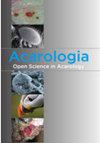以不同花粉粒为食的威氏钝绥螨(蜱螨亚纲:植螨科)的发育、生存和繁殖
IF 0.9
3区 农林科学
Q3 ENTOMOLOGY
引用次数: 0
摘要
以8种不同植物的花粉为食,研究了捕食性螨(蜱螨亚纲:植螨科)的发育、繁殖、存活和种群生长率;白花苜蓿(L.)Benth。]、枣椰树(Phoenix dactylifera L.)、海参(Prosopis cineraria L.)[麻],蓖麻(Ricinus communis L.),玉米(Zea mays L.),向日葵(Helianthus annuus L.),狗尾草[Imperata圆柱形(L.)]测定。在25±1°C、65±5%相对湿度和16:8 h (L: D)的光照条件下,玉米和枣椰树的花粉在想象前发育过程中没有任何死亡率,而红草花粉的未成熟死亡率最高。以葵花花粉为食物源时,雌雄幼体发育时间最长,以蓖麻豆花粉最短,其次是枣棕花粉。以玉米花粉为食的雌蜂产卵数量最多,而以枸杞为食的雌蜂产卵数量最少。内在增长率(r)和有限增长率(λ)在枣椰树花粉中最高,在梧桐草中最低。总体而言,我们发现枣椰树和玉米花粉是最有希望的替代食物来源,因为以枣椰树和玉米花粉饲养的种群没有成虫前死亡,产卵期最长,繁殖力和种群增长率最高。本文章由计算机程序翻译,如有差异,请以英文原文为准。
Development, survival, and reproduction of Amblyseius swirskii (Athias- Henriot) (Acari: Phytoseiidae) feeding on different pollen grains
In the present study, the development, reproduction, survival, and population growth rate of the predatory mite Amblyseius swirskii Athias- Henriot (Acari: Phytoseiidae) were evaluated when fed on pollen of eight different plant species; lebbeck [Albizia lebbeck (L.) Benth.], date palm (Phoenix dactylifera L.), Khejri [Prosopis cineraria (L.) Druce], castor bean (Ricinus communis L.), maize (Zea mays L.), sunflower (Helianthus annuus L.), cogongrass [Imperata cylindrical (L.) P. Beauv.], and cattail (Typha sp.), at 25 ± 1 °C, 65 ± 5% relative humidity and a photoperiod of 16:8 h (L: D). Pollen of maize and date palm did not exert any mortality during pre-imaginal development, while the highest immature mortality was observed on cogongrass pollen. The longest immature development of both sexes was obtained when sunflower pollen was the food source, whereas it was shortest on castor bean pollen followed by date palm pollen. Females fed on maize pollen laid the highest number of eggs, while the females on cogongrass laid the lowest number. The intrinsic rate of increase (r) and the finite rate of increase (λ) were highest on date palm pollen and the lowest on cogongrass. Overall, we found that date palm and maize pollen are the most promising alternative food sources of the species tested for A. swirskii because populations reared on date palm and maize pollen showed no pre-adult mortality and had the longest oviposition period, and the highest fecundity and population growth rates.
求助全文
通过发布文献求助,成功后即可免费获取论文全文。
去求助
来源期刊

Acarologia
ENTOMOLOGY-
CiteScore
2.00
自引率
18.20%
发文量
81
期刊介绍:
Acarologia is a free open-access journal. Please help us by submitting manuscripts in accordance with following instructions.
All manuscripts which do not conform to the instructions will be returned to authors without the benefit of review.
Acarologia publishes the results of original research on all aspects of Acarology.
The journal policy is that taxonomic descriptions should include several species within a same genus/family, when possible.
The editors reserve the right to refuse manuscripts when authors intentionally divide individual species descriptions of the same genus/family into distinct publications.
Single species descriptions should be clearly justified based on their scientific interest.
 求助内容:
求助内容: 应助结果提醒方式:
应助结果提醒方式:


